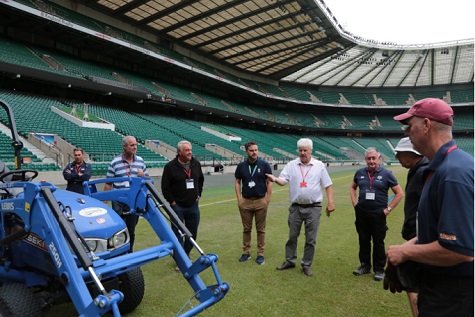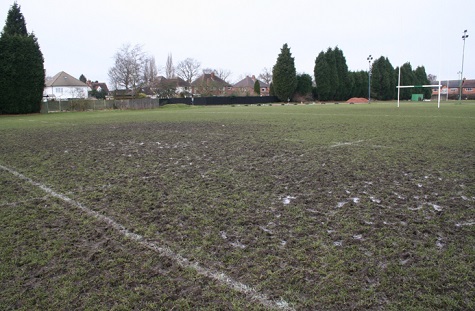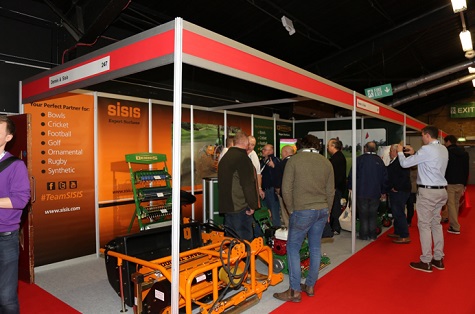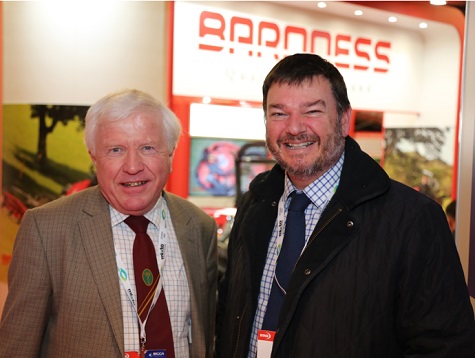As a keen sportsman and ex rugby player, I really enjoyed both last weekend’s and this week’s Six Nations Tournament. A great spectacle and a tremendous start for England beating Ireland on their own patch followed by an empathic win over France at Twickenham.
However, credit must also go to all of the stadiums’ groundstaff who work tirelessly to prepare these pitches for the tournament. It is a full-on task to keep these pitches playable at probably the worst time of the year. Without the investment of lighting rigs, reinforced pitches and a plethora of plant feeding health products, I’m not sure whether they would be able cope with the rigors of modern test rugby.

The demands on the pitch is not just one rugby match. Each and every stadium has to cope with several activities leading up to the game with practice sessions, captain’s runs, along with a lot of pre and post-match activities such as hoovering, brushing, aerating, mowing, feeding and applying any relevant soil amendments to maximise growth and recovery.
Playing these matches at this time of the year not only tests the skills and experience of the groundstaff to prepare these pitches, the challenging weather fronts often influence how the teams play on the day. I am sure we are going to enjoy some great matches in the weeks to come.
While on the subject of the weather, also spare a thought for all those grassroots club groundsmen who also have to prepare and maintain natural grass pitches at this time of the year, often with limited resources.
Winter game pitches generally take a hammering around now. Without the advantage of grow lights and unlimited resources grassroot clubs have to rely on working with the weather. Ideally you should not envisage playing on a natural turf pitch if it’s in a saturated state, with water not draining away. If you do, you are likely to lose a lot of grass cover and make things worse. Best left alone and wait for the pitch to dry out.

Both the FA and RFU and RFL websites give relevant advice on winter maintenance of sports pitches. The RFU have in recent years instigated a Groundsman Connect initiative.
This is something I personally advocate joining, as you have access to good advice and information about a range of products and services available.
I am still recovering from the exploits of attending BTME. Again I would like to commend all the exhibitors for their ongoing commitment to supporting the show. The thirst for knowledge and education is now greater than ever.
It is astounding how complex the role of a groundsman / greenkeeper is becoming. So many skills required to deliver the new expectations of their employers and employees. The diverse amount of complex machinery now on offer to maintain these facilities efficiently is astounding.

Not only tasked with getting the job done, it is also ensuring they are compliant in all the activities they undertake in terms of machinery certification, chemical usage and operator safety. All in all, a lot of legislation and red tape to control and manage.
That’s why I think it is important we seek assistance and help from many of the organisations we now have supporting our industry. First port of call is your own sporting governing body, such as ECB, R&A, LTA, RFU, RFL, FA, Bowls England. We can then look at other supporting organisations like BIGGA, IOG, STRI, BASIS, BAGMA and Amenity Forum to name a few.
Without a doubt, our improved efficiencies have come from the vast range and choice of machinery we can now invest in. However, it is key we work closely with both the manufacturers and suppliers to ensure we have invested in the right product and more importantly we look after it.
In recent years we have seen an increase in the use of mechanical sprayers for applying an array of herbicide products, growth regulators, bio stimulants and plant feeds. It is important we ensure that these sprayers are kept in good order and calibrated and checked on a regular basis.
The Amenity Forum is the UK based, industry led voluntary initiative for the promotion of “best practice” principles within the amenity sector when using pesticides, herbicides, fungicides, insecticides, algaecides and other products to control pests and diseases in this diverse sector.
Membership of the Amenity Forum is open to individuals and organisations involved in weed and pest control in the sector. Indeed, it is very much welcomed to demonstrate our voluntary commitment to drive up standards and promote best practice.

In recent years the Amenity Forum has been promoting the Amenity Spray Operator of theYear (ASOY) awards sponsored by ICL and Syngenta, in association with BASIS.
This year’s award was presented at BTME to Keith Gallacher. As well as the overall top operator, Keith was also the winner of the Landscape and Industrial using vehicle mounted equipment category.
Two other category winners were also recognised by the Awards. Ryan Shepherd of Hortech won Landscape and Industrial sprayer using a knapsack, while Andy Baker won the category for Sports turf using a boom sprayer or knapsack.
Commenting on Keith’s success, from a record entry in the fourth annual ASOY Awards, Professor John Moverley, chairman of the Amenity Forum, said, ‘‘What is done to maintain amenity areas impacts upon every UK citizen every day and is important to ensure healthy and safe environments fit for purpose. This work depends upon the input of highly professional operators fully trained and qualified. A key element in the task is the use of authorised and safe chemical spraying.

“The Amenity Forum Sprayer Operator of the Year Awards seek to highlight the very best practice and identify those individuals who go above and beyond in their work.
“Syngenta recognises that the skills of the sprayer operator are paramount in achieving the full potential from all applications and assuring future sustainable use,” he added.
Stephen Jacob, BASIS CEO commented, “The safe and appropriate application of plant protection products is essential to maintaining the environment in which we live, and it’s clear that Keith is a true advocate of these principles.”
Also important to note, these sprayers need to be inspected and tested on a regular basis. The Plant Protection Products (Sustainable Use) Regulations 2012 states that all types of PAE must be tested to certain timescales depending on the age of the machine.
The legislation relates to all sectors, agriculture, horticulture, amenity and fruit, but for anyone applying a professional pesticide, the equipment must be tested. Application equipment that does not require an NSTS test are knapsacks, handheld and pedestrian equipment. These need to be inspected by a competent person, repairs made as required and a record kept. For knapsack sprayers a checklist is available to use and record the results.
The NSTS provide testing for all types of Pesticide Application Equipment (PAE) and fertiliser spreaders. The scheme was introduced in 2002 following the introduction of a voluntary scheme set up in 1997 by the Agricultural Engineers Association (AEA) and today tests more than 20,000 machines annually.